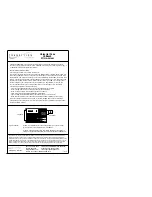
T
ROUBLE
S
HOOTING
➠
39
Video RSatellite Receiver
12
➠
38
Video RSatellite Receiver
T
ROUBLE
S
HOOTING
There are interferences
on your digital satellite
channels, caused by an
existing terrestrial
channel or video signal.
The remote control is
not working.
PROBLEM
POSSIBLE CAUSES
WHAT TO DO
The system is connected by
RF leads and the output
channel of the Digital
Satellite Receiver is
interfered with an existing
terrestrial channels or video
signal.
Battery is exhausted.
Remote control is
incorrectly aimed.
Change the Digital Satellite
Receiver output channel to a
more suitable channel, or
connect the system by SCART
leads.
Change the batteries.
Aim the remote control at
Digital Satellite Receiver, or
check that nothing blocks the
front panel.
VCR receiver does not
seem to work / you can’t
see the VCR receiver
output on the TV set.
Are there any lights on the front panel?
No
• Make sure all leads are firmly connected to the VCR
receiver and VCR/TV.
• Check there is power to the socket powering VCR receiver
(and that it’s switched on).
• Check the fuse in the plug.
Yes
Is a VCR connected between VCR receiver and the TV? Ensure
it is on and all leads are correctly attached.
• Try connecting VCR receiver directly to your TV set to see if
your VCR is faulty..
• Check you have the correct channel selected on your TV set.
IF THE PROBLEM PERSISTS, PLEASE CONTACT YOUR DEALER OR SERVICE PROVIDER.
No sound or picture,
and the front panel
shows red light.
No sound or picture.
Bad picture / blocking
error
No Welcome Menu on
the screen after you
switched on the Digital
Satellite Receiver for
the first time.
PROBLEM
POSSIBLE CAUSES
WHAT TO DO
The Digital Satellite
Receiver is in stand-by
mode.
The satellite dish is not
pointing at the satellite.
No signal or weak signal.
The satellite dish is not
pointing at the satellite.
Signal is too strong.
Satellite dish is too small.
LNB noise factor is too
high.
The LNB is faulty.
The system is connected by
SCART leads, and TV is not
in AV mode.
The system is connected by
RF leads.
Press the [stand-by] button.
Adjust the dish. Check the
signal level in the Channel
Search menu.
Check the cable connections,
LNB, and other equipment
connected between the LNB
and the receiver, or adjust the
dish.
Adjust the dish.
Connect a signal attenuator to
the LNB input.
Change to a larger dish.
Change to an LNB with lower
noise factor.
Change the LNB.
If the system is connected by
SCART leads, switch the TV to
the appropriate AV input.
Check the UHF channel fixed
in your system and tune the
UHF channel properly.
12


































